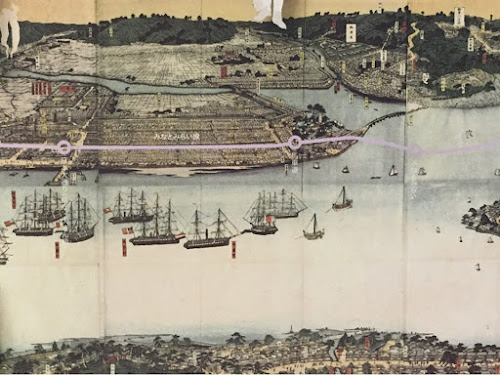Finale of her travel in Japan、日本の旅の終わり
3rd of December in Kobe、12月3日神戸にて
Isabella visited her acquaintance in Osaka which was a vivid big city with 600,000 people.
 |
The theater in Doton-bori in the Meiji
period
明治時代の道頓堀・弁天座
http://dl.ndl.go.jp/info:ndljp/pid/762807/65
|
She mentioned women’s status was not low. According to her, the wives of poor families were happier than the ones of rich families. They worked hard but they were co-workers of their husbands. Husbands were not boss. Single women were not discriminated. Boys and girls were brought up equally with love. They were educated in the same way.
The status of Japanese women might have been relatively high among the world.
イザベラは大阪の知人を訪ね、人口60万の活気ある大都市・大阪を回った。また、女性の地位について、次のように記している。
「---日本の妻は金持ち階層より貧しい階層の方が幸せだというのが私が受けた印象である。よく働くけれども、夫にこき使われるのもというよりむしろ夫の協働者なのである。また、同じ階層の中でなら、結婚していなくても世間から隔離されていないし、一定の範囲内では完全な自由を有している。--- 男女の別なく慈しみを持って育てられるし、女の子も男の子と同じように身分相応の教育をきちんと受ける。」とあり、イザベラから見ても女性の地位が高かったことが分かる。
LETTER44
H.B.M.’s LEGATION, YEDO, December18
12月18日東京の英国公使館にて
She enjoyed final days in Japan.” I have
spent the last ten days here, in settled fine weather, ---.” She visited tourist
spots near Tokyo and wrote “---, and to Enoshima and Kamakura, “vulgar”
resorts which nothing can vulgarise so long as Fujisan towers above them.” 12月18日東京の英国公使館にて
 |
Her sketch of the village in Toukaidou
Highway and Mt.Fuji
イザベラの東海道の村
|
Finally, she left Japan. She wrote, “The
snowy dome of Fujisan reddening in the sunrise rose above the violet woodlands
of Mississippi Bay (Tokyo Bay) as we steamed out of Yokohama Harbour on the 19th,
and three days later I saw the last of Japan – a rugged coast, lashed by a
wintry sea.”
イザベラは富士山を遠望しながら日本を離れていく。 |
Yokohama in 1865、「増補開国御開港横浜の全図」(1865)
五雲亭貞秀@横浜駅地下通路 |
The fun of Japanese founded by Isabella L. Bird in 1878
イザベラが見た明治初期の日本人の楽しみ
1.
Fun of the pastimes with
children、子どもと過ごす楽しみ
It would be a common sense that spending a time
with children is fun, I think. However, she mentioned that Japanese loved children too much. She wrote “child-worship being more common in Japan”
(Part7). Playing the game with children, watching children who were playing the
game, going to festivals and buying various toys, and lifting them. It is
really fun and affordable. She wrote Ainus loved children more than Japanese.
There was less entertainment back then. It was a key driver to cherish children
probably.Reference: Kanaya family in Nikko (part3)、Festival in Tsuchizaki (part6)、Letter written in Ikarigaseki (part7)、Runners of rickshaws and festival in Otsu (part11)、Aino family(part9)
 |
| Nagareyama city museum、流山市博物館 |
子どもと過ごすことは世界共通の楽しみだと思うが、イザベラは日本人が子どもを大切にすること、ある面、甘やかすことを「子ども崇拝(worship)」(part7)とまで書いている。子どもと一緒にゲームをしたり、子どもたちがゲームをするのを見守ったり、祭に出かけて色々と買ってあげたり、抱っこしたり。これは、楽しみだし、しかも、安上がりだ。アイヌは、もっと子どもを愛していると書いている。娯楽が少ない方が、子どもを大切にするのかも知れない。
参考:日光の金谷家(part3)、秋田・土崎の祭(part6)、碇ヶ関での手紙(part7)、伊勢に行くのに雇った車夫の話・大津の祭(part11)、アイヌの家族(part9)
She complained a lot about Japanese noisy parties. But I know it is fun to drink until late at night while playing music. It was not just drinking, it was a party with performances by people.
On the other hand, she mentioned that Chinese drank quietly and gently. She praised it. Recently, Chinese parties were very noisy, so it changed.
Reference: Inn in Kasukabe(part2)、Nikko Yumoto onsen resort and Kanaya house (part3)、Sanaburi party in Aizu (part4)、Kaminoyama onsen resort (part5)、Oodate (part6)、Mori in Hokkaidou (part9)
 |
イザベラは日本人の宴会に眉をひそめているが、飲んで、音楽を奏でて、遅くまで遊んでいたのが良く分かる。ただ飲むだけで無く、三味線や芸が飛び出しているのが楽しい。
一方、中国では、飲み癖が良いようで、「中国人は、とても穏やかに酒をたしなみ、たいていは食事をしながら飲むという長所がある」と記載している(完訳本)。今では、中国人は大騒ぎしていると思うが、イザベラの当時はそうではなかった。参考:春日部宿(part2)、日光湯元温泉・金谷家(part3)、会津地方での「さなぶり」(part4)、上山温泉(part5)、大館(part6)、北海道の森(part9)
3.
Fun of the festivals、祭の楽しみ
It is no doubt that festivals are fun. Isabella
pointed out dressed-up people went to the festival happily, bought something from the stands, and they showed their valuables at the time of festival
(Otsu). At the end of her travel, she wrote that Japanese didn’t believe in any deities. Going to shrines and temples were just a picnic, moreover religious festivals were just a En-nich carnival (Part10). Anyway, visiting shrines and temples has been fun for Japanese.
Reference: Festival in Tsuchizaki (Part6)、Kite fighting (Part7)、Festival in Kuroishi (Part8)、Festival of Ainus (Part9)、Festival in Otsu(Part11)
 |
| Neputa festival in Asakusa、浅草祭での弘前ねぷた |
イザベラは、旅の最後に、「私がこれまでに会ってきた国民のうちで日本人ほど信仰心のない国民はいない。寺社詣でと言っても行楽であるし、宗教に関わる祭りといっても縁日に過ぎない」と喝破している(Part10)。とにかく、寺社詣や祭は日本人の楽しみだ。
参考:秋田/土崎の祭(Part6)、凧合戦(Part7)、黒石ねぷた祭(Part8)、アイヌ・イヨマンテの祭(Part9)、大津の祭(Part11)
4.
Fun of the onsen hot
spring、温泉の楽しみ
She wrote the people who enjoyed onsen in some
places. Soaking in the bath tub and relaxing, then playing Japanese guitars and singing. Those
are really fun. Japan is in a volcanic region, so there are a lot of onsen
resorts.Reference: Nikko Yumoto onsen (part3)、Akayu and Kaminoyama onsen (part5)、Nakano onsen (part8)
 |
Brochure of Asama onsen tourist association
浅間温泉観光協会パンフレット
|
日光湯元、山形の赤湯と上山、青森の中野で温泉を楽しむ人たちを記載する。湯につかり、三味線や琴をかき鳴らして宴会をする。火山地帯で温泉が多い日本では、いまでも温泉旅行が大人気だ。
参考:日光湯元温泉(part3)、上山温泉(part5)、中野温泉(part8)
5.
Fun of city life、都市・繁華街の楽しみ
Fun in Asakusa (Part2) and Kyoto (Part11) were
described. Big cities were kinds of amusement parks.Reference: 江戸生活事典Life in Edo, old Tokyo (published in 1959)
浅草の歓楽街(Part2)、京都の着道楽(Part11)が書かれている。都市には都市の楽しみがある。
 |
| Douton-bori in present in Osaka、大阪・道頓堀 |
6. Fun of intelligence、知的楽しみ
A gentleman enjoyed reading in deep mountains which was 15km away from Nikko Highway. She wrote, “a decent-looking middle-aged man lying on his chest in the verandah, raised on his elbows, and intently reading a book, ---" (Part4). Expanding our knowledge is excellent enjoyment.
日光街道から15kmほど北に行った藤原辺りでは、上品な中年の男がベランダで熱心に本を読んでいたという(Part4)。山中の家にも本があり、本を見る知の悦びがある。
She brought medicine such as painkillers, and cured
Japanese. She also had sweets to present. I can say she knew how to fraternize
with local people. Therefore, she found a lot of habit of Japanese people including
enjoyment. I respect her courage for traveling, her curiosity and her effort to
write this book.
イザベラは鎮痛剤などの薬剤を持っていて、日本人を治療した。お菓子ももっていたし、現地人に入り込むすべを知っていた。だから多くの日本人の楽しみを見つけられたと思う。こんな旅ができるなんて、彼女の旅する勇気と好奇心、そして旅行記を残したことを尊敬する。Reference: Isabella L. Bird, Manga version in Japanese (マンガ版)
https://www.amazon.co.jp/%E3%81%B5%E3%81%97%E3%81%8E%E3%81%AE%E5%9B%BD%E3%81%AE%E3%83%90%E3%83%BC%E3%83%89-1%E5%B7%BB-%E3%83%93%E3%83%BC%E3%83%A0%E3%82%B3%E3%83%9F%E3%83%83%E3%82%AF%E3%82%B9-%E4%BD%90%E3%80%85-%E5%A4%A7%E6%B2%B3/dp/4047305138
Previous post (Go to Ise Shrine by
rickshaw、伊勢神宮へ):
Travel
of Isabella L. Bird in 1878, part 11 イザベラバードが見た明治初期の日本(11) Next post (Museum in my city、我が町の博物館):
There are 12 articles about Isabella's travel in Japan. The first page:
イザベラバードの旅は全12ページの記事です。最初の記事は上記のURLになります。
Comments
Post a Comment